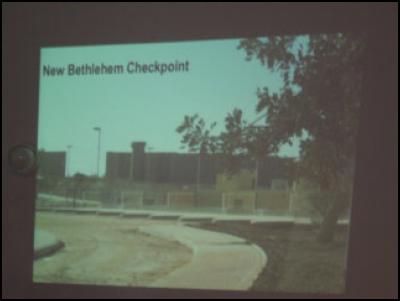Nonviolence Movement in Israel and Palestine
Nonviolence Movement in Israel and Palestine
By Sonia Nettnin

American Friends Service Committee Quaker Representatives Paul Pierce and Kathy Kamphoefner spoke about the nonviolence movement in Israel and Palestine at Chicago’s Agape House. Christian Peacemaker Team representative Mark Frey, along with Jesse Bacon from Not In My Name talked about their experiences in the region also.
The organizations work in Jerusalem and Hebron where they provide non-violence-resistance-training. The organizations go to villages throughout the West Bank and Gaza, where requests for nonviolence-resistance-training are in high demand. The representatives gave a presentation called “Faces of Hope – Acts of Courage,” which detail the stark facts on the ground.
Since the beginning of the second Intifada in September 2000, Israel soldiers and civilians killed totals more than 989, and 101 of this number are children; Israelis injured are almost 6800. Palestinians killed total around 3400, with almost 650 of them children. The figures shows three times as many Palestinians killed as Israelis; and Palestinians injured total around 28,200. The representatives extracted figures from the Israeli Ministry of Foreign Affairs and the Palestine Monitor.
Beginning September 29, 2004 through October 15, 2000 Israel carried out its “Days of Repentance” Operation in Gaza, named after Yom Kippur. They killed 133 Palestinians and three Israelis. Out of those figures, 26 are Palestinian children and two are Israeli children. During this operation, Palestinians injured total 430. Homes damaged total 235 and the operation demolished 85 homes completely. These figures are from B’Tselem.org.
“The separation barrier is nine meters high,” Pierce said. “It is cutting through Palestinians towns.”
For example in the Palestinian town of Abu-Dis, the separation wall is through the middle of the town. When people go for worship, only 2,000 people have access. The separation wall prevents people from reaching schools and hospitals. The coastline along the Dead Sea is now Israeli private resorts.
Land lost for Palestinians total 943,000 dunams, or 16.8 per cent. Palestinians affected total 875,600 or 38 per cent of the population. Some Israeli settlers attack Palestinians in their homes or they set their homes on fire. Religious hate crimes against Muslims are sometimes spray painted on the walls. For example, settlers spray painted a pig with a kufiyeh on its head reading Islam’s holy book the Qur’an. Muslims do not eat pork; the kufiyeh is a part of Arab culture. Thus, the offenses are three-fold: religious, racist and cultural.
The Christian Peacemaker Team is active in walking Palestinian children to school. Four months ago, settlers attacked the internationals and punctured one person’s lung into collapse. Another person was hit in the knee.
Israeli conscientious objectors (Refuseniks) are growing in the region. Most of the Refuseniks are college-age men and women. When asked to report for duty, the people stand before a military board and argue pacifism. Sometimes, they will be sent to prison for 28-day-cycles. Upon return, if they still argue pacifism, they may be sent to prison again. One man went to prison for four sentences. While he was there, the other prisoners beat him.
Israel’s occupation involves assassinations, home demolitions, military abuse, checkpoints, roadblocks, settler-only by-pass roads, settler expansion, land confiscation, settler harassment, and the imbalance of water distribution. There are three aquifers in the region. Israelis use 80 per cent of the water and the Palestinians use 20 per cent. As a result, there is a five-to-one ratio of Israeli-to-Palestinian water consumption. Palestinians consume less than the world minimum daily. In Rafah, there are two wells for water consumption. In the past, Israeli soldiers attacked those wells.
Although there are 140 checkpoints in the West Bank, flying checkpoints increase that number. Israeli soldiers will block roads with cars and tanks, where they can stop people instantly.
The speakers demonstrated the existence of a growing nonviolence movement in Israel and in Palestine. They said suicide bombings are a dangerous and horrible way of resisting.
Out of this violent and tragic conflict, there are many reasons for hope.
Sonia Nettnin is a freelance writer. Her articles and reviews demonstrate civic journalism, with a focus on international social, economic, humanitarian, gender, and political issues. Media coverage of conflicts from these perspectives develops awareness in public opinion.
Nettnin received her bachelor's degree in English literature and writing. She did master's work in journalism. Moreover, Nettnin approaches her writing from a working woman's perspective, since working began for her at an early age.
She is a poet, a violinist and she studied professional dance. As a writer, the arts are an integral part of her sensibility. Her work has been published in the Palestine Chronicle, Scoop Media and the Washington Report on Middle East Affairs. She lives in Chicago.


 Binoy Kampmark: The Australian Defence Formula, Spend! Spend! Spend!
Binoy Kampmark: The Australian Defence Formula, Spend! Spend! Spend! Ian Powell: New Hospital Building Trumps ‘Yes Minister’ Hospital Without Patients
Ian Powell: New Hospital Building Trumps ‘Yes Minister’ Hospital Without Patients Mike Treen: Prices Are Still Rising - It's A Cost Of Living Crisis
Mike Treen: Prices Are Still Rising - It's A Cost Of Living Crisis Gordon Campbell: On When Racism Comes Disguised As Anti-racism
Gordon Campbell: On When Racism Comes Disguised As Anti-racism Peter Dunne: Newshub And TVNZ Tip Of Media Iceberg
Peter Dunne: Newshub And TVNZ Tip Of Media Iceberg Harry Finch: Austerity – For And Against
Harry Finch: Austerity – For And Against